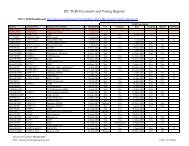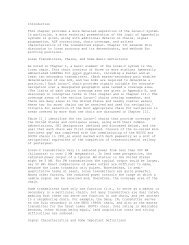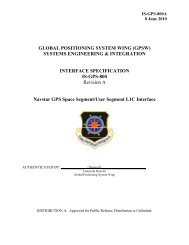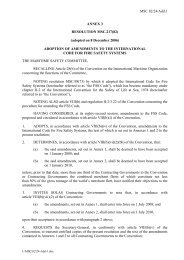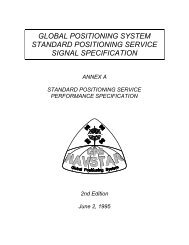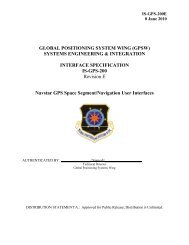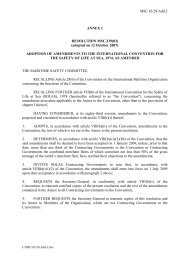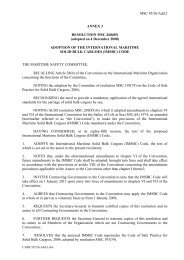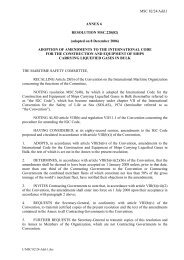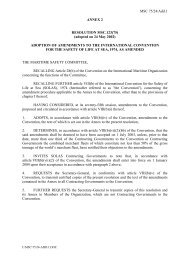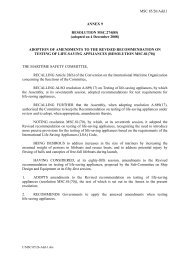MSC 82/24/Add.1 ANNEX 10 RESOLUTION MSC.224(82) (adopted ...
MSC 82/24/Add.1 ANNEX 10 RESOLUTION MSC.224(82) (adopted ...
MSC 82/24/Add.1 ANNEX 10 RESOLUTION MSC.224(82) (adopted ...
- No tags were found...
Create successful ePaper yourself
Turn your PDF publications into a flip-book with our unique Google optimized e-Paper software.
<strong>MSC</strong> <strong>82</strong>/<strong>24</strong>/<strong>Add.1</strong><strong>ANNEX</strong> <strong>10</strong><strong>RESOLUTION</strong> <strong>MSC</strong>.2<strong>24</strong>(<strong>82</strong>)(<strong>adopted</strong> on 8 December 2006)ADOPTION OF AMENDMENTS TO THE CODE OF SAFETY FORDYNAMICALLY SUPPORTED CRAFT, AS AMENDEDTHE MARITIME SAFETY COMMITTEE,RECALLING Article 28(b) of the Convention on the International Maritime Organizationconcerning the functions of the Committee,RECALLING ALSO resolution A.373(X) by which the Assembly, at its tenth session,<strong>adopted</strong> the Code of Safety for Dynamically Supported Craft,NOTING that the Assembly, when adopting resolution A.373(X), authorized theCommittee to amend the Code as may be necessary,HAVING CONSIDERED, at its eighty-second session, amendments to the Code ofSafety for Dynamically Supported Craft, prepared by the Sub-Committees on Ship Design andEquipment and on Safety of Navigation,1. ADOPTS amendments to the Code of Safety for Dynamically Supported Craft, asamended, the text of which is set out in the Annex to the present resolution;2. DETERMINES that the above-said amendments should become effective on 1 July 2008.I:\<strong>MSC</strong>\<strong>82</strong>\<strong>24</strong>-Add-1.doc
<strong>MSC</strong> <strong>82</strong>/<strong>24</strong>/<strong>Add.1</strong><strong>ANNEX</strong> <strong>10</strong>Page 2<strong>ANNEX</strong>AMENDMENTS TO THE CODE OF SAFETY FORDYNAMICALLY SUPPORTED CRAFT, AS AMENDEDCHAPTER 1GENERAL1 The following new paragraph 1.1.5 is added after existing paragraph 1.1.4:“1.1.5 New installation of materials containing asbestos used for the structure,machinery, electrical installations and equipment of a craft to which this Code appliesshould be prohibited except for:.1 vanes used in rotary vane compressors and rotary vane vacuum pumps;.2 watertight joints and linings used for the circulation of fluids when, at hightemperature (in excess of 350°C) or pressure (in excess of 7 x <strong>10</strong> 6 Pa),there is a risk of fire, corrosion or toxicity; and.3 supple and flexible thermal insulation assemblies used for temperaturesabove <strong>10</strong>00°C.”CHAPTER 8LIFE-SAVING APPLIANCES2 The following new paragraph 8.2.9 is inserted after the existing paragraph 8.2.8:“8.2.9 Periodic servicing of launching appliancesLaunching appliances:.1 should be serviced at recommended intervals in accordance withinstructions for on-board maintenance as required by regulation III/36 ofthe Convention;.2 should be subjected to a thorough examination at the annual surveysrequired by paragraph 1.5.1(b); and.3 should, upon completion of the examination in .2, be subjected to adynamic test of the winch brake at maximum lowering speed. The load tobe applied should be the mass of the survival craft or rescue boat withoutpersons on board, except that at intervals not exceeding five years, the testshould be carried out with a proof load equal to 1.1 times the weight of thesurvival craft or rescue boat and its full complement of persons andequipment.”3 The following new sections 8.7, 8.8 and 8.9 are inserted after existing section 8.6:I:\<strong>MSC</strong>\<strong>82</strong>\<strong>24</strong>-Add-1.doc
<strong>MSC</strong> <strong>82</strong>/<strong>24</strong>/<strong>Add.1</strong><strong>ANNEX</strong> <strong>10</strong>Page 3“8.7 Servicing of inflatable liferafts, inflatable lifejackets, marine evacuationsystems and inflatable rescue boatsEvery inflatable liferaft, inflatable lifejacket and MES should be serviced:I:\<strong>MSC</strong>\<strong>82</strong>\<strong>24</strong>-Add-1.doc.1 at intervals not exceeding 12 months, provided where in any case this isnot practicable, the Administration may extend this period by one month;.2 at an approved service station which is competent to service them,maintains proper servicing facilities and uses only properly trainedpersonnel. *8.8 Rotational deployment of marine evacuation systemsIn addition to, or in conjunction with, the servicing intervals of marine evacuationsystems required above, each marine evacuation system should be deployed from thecraft on a rotational basis at intervals to be agreed by the Administration, provided thateach system is to be deployed at least once every six years.8.9 Novel life-saving appliances or arrangements8.9.1 Before giving approval to novel life-saving appliances or arrangements, theAdministration should ensure that such appliances or arrangements:.1 provide safety standards at least equivalent to the requirements of thischapter and have been evaluated and tested in accordance with therecommendations of the Organization; ** or.2 have successfully undergone, to the satisfaction of the Administration,evaluation and tests which are substantially equivalent to thoserecommendations.8.9.2 An Administration which approves new and novel inflatable liferaft arrangementspursuant to 8.9.1 may allow for extended servicing intervals under the following conditions:.1 The new and novel liferaft arrangement should maintain the samestandard, as required by testing procedures, throughout the extendedservicing intervals..2 The liferaft system should be checked on board by certified personnelaccording to 8.7..3 Service at intervals not exceeding five years should be carried out inaccordance with the recommendations of the Organization.______________*Refer to the Recommendations on conditions for the approval of servicing stations for inflatableliferafts, <strong>adopted</strong> by the Organization by resolution A.761(18) as amended by resolution <strong>MSC</strong>.55(66).**Refer to the Code of Practice for the Evaluation, Testing and Acceptance of Prototype NovelLife-Saving Appliances and Arrangements, <strong>adopted</strong> by the Organization by resolution A.520(13).
<strong>MSC</strong> <strong>82</strong>/<strong>24</strong>/<strong>Add.1</strong><strong>ANNEX</strong> <strong>10</strong>Page 48.9.3 An Administration which permits extension of liferaft service intervalsin accordance with 8.9.2 should notify the Organization in accordance withregulation I/5(b) of the Convention.”CHAPTER 13RADIOCOMMUNICATION AND NAVIGATIONAL EQUIPMENT4 In paragraph 13.1, the words “as amended (up to and including resolutions <strong>MSC</strong>.69(69),<strong>MSC</strong>.123(75) and <strong>MSC</strong>.152(78))” are inserted at the end.5 The text of existing paragraph 13.2 under the heading “Navigation – General” isrenumbered as 13.2.1 and the following new paragraph 13.2.2 is inserted:“13.2.2 The navigation equipment and its installation should be to the satisfaction ofthe Administration. The Administration should determine to what extent the navigationalequipment provisions of this chapter do not apply to craft below 150 gross tonnage.”6 The following new paragraphs 13.<strong>10</strong>, 13.11 and 13.12 are inserted after existingparagraph 13.9:“13.<strong>10</strong> Automatic identification system13.<strong>10</strong>.1 Craft should be provided with an automatic identification system (AIS) asfollows:.1 in the case of passenger craft, no later than 1 July 2008;.2 in the case of cargo craft of 3,000 gross tonnage and upwards, no laterthan 1 July 2008; and.3 in the case of cargo craft of less than 3,000 gross tonnage, no laterthan 1 July 2008.13.<strong>10</strong>.2 AIS should:.1 provide automatically to appropriately equipped shore stations, other craftand aircraft information, including the craft’s identity, type, position,course, speed, navigational status and other safety-related information;.2 receive automatically such information from similarly fitted craft;.3 monitor and track craft; and.4 exchange data with shore-based facilities.13.<strong>10</strong>.3 The requirements of 13.<strong>10</strong>.2 should not be applied to cases where internationalagreements, rules or standards provide for the protection of navigational information.I:\<strong>MSC</strong>\<strong>82</strong>\<strong>24</strong>-Add-1.doc
<strong>MSC</strong> <strong>82</strong>/<strong>24</strong>/<strong>Add.1</strong><strong>ANNEX</strong> <strong>10</strong>Page 513.<strong>10</strong>.4 AIS should be operated taking into account the guidelines <strong>adopted</strong> by theOrganization. *13.11 Voyage data recorders (VDR) **13.11.1 To assist in casualty investigations, all passenger craft, including existingpassenger craft, should be fitted with a voyage data recorder (VDR).13.11.2 The Administration may exempt passenger craft, other than ro-ro passengercraft, from being fitted with a VDR where it can be demonstrated that interfacing a VDRwith the existing equipment on the craft is unreasonable and impracticable.13.11.3 The voyage data recorder system, including all sensors, should be subjected toan annual performance test. The test should be conducted by an approved testing orservicing facility to verify the accuracy, duration and recoverability of the recorded data.In addition, tests and inspections should be conducted to determine the serviceability ofall protective enclosures and devices fitted to aid location. A copy of the certificate ofcompliance issued by the testing facility, stating the date of compliance and the applicableperformance standards, should be retained on board the craft.13.12 Nautical charts and publications13.12.1 All craft, including existing craft, should be provided with nautical charts andnautical publications to plan and display the craft’s route for the intended voyage and toplot and monitor positions throughout the voyage. An electronic chart display andinformation system (ECDIS) may be accepted as meeting the chart carriage requirementsof this paragraph.13.12.2 All craft, including existing craft, should be fitted with an ECDIS not laterthan 1 July 20<strong>10</strong>.13.12.3 Back-up arrangements should be provided to meet the functional requirementsof 13.12.1, if this function is partly or fully fulfilled by electronic means. *** ”_____________******Refer to Guidelines for the onboard operational use of shipborne automatic identification systems(AIS), <strong>adopted</strong> by the Organization by resolution A.917(22).Refer to Recommendation and Performance Standards for voyage data recorders (VDR’s), <strong>adopted</strong> bythe Organization by resolution A.861(20).An appropriate portfolio of paper nautical charts may be used as a backup arrangement for ECDIS.Other backup arrangements for ECDIS are acceptable (see appendix 6 to resolution A.817(19), asamended).***I:\<strong>MSC</strong>\<strong>82</strong>\<strong>24</strong>-Add-1.doc




